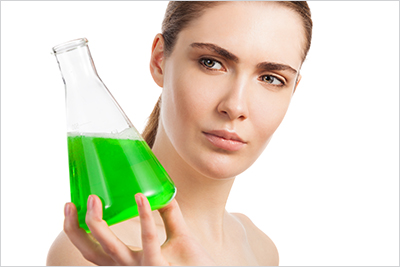Is Triclosan Safe or Effective?
Posted by Katie Zapotoczny on 13th Mar 2015

In January, I looked at 5 ingredients that Verefina does not use in any of its products. One of these ingredients is triclosan, an antibacterial agent that is frequently added to soaps. Today I want to take a closer look at triclosan. Adding this ingredient to soap may seem like a good idea on the surface. After all, killing germs should help prevent illness. In recent years, however, there have been increasing concerns about this synthetic chemical, and it is becoming clear that there are many problems with it.
Concerns with Triclosan
Triclosan was originally created for use in surgical scrubs in hospitals, and it was first registered with the Environmental Protection Agency as a pesticide (source). It is still registered as a pesticide today (source). While triclosan is regulated in many countries, it is not regulated here in the U.S. (source). Triclosan is now found not only in hand soaps, but also in other personal care products such as acne creams, cosmetics, and toothpaste. And it is also sometimes put on yoga mats, kitchen utensils, furniture, bedding, and toys. Studies are finding that adding triclosan to so many products has a number of adverse health effects.
Bacterial Resistance
Triclosan is anti-bacterial, which means that it does not affect viruses or other microbes. However, many common illnesses, such as colds, flu, and some stomach bugs (the dreaded norovirus, for example), are caused by viruses, not bacteria. So triclosan really is not helpful when it comes to preventing such illnesses. As for eliminating bacteria, there are concerns that triclosan may not kill all of it. Laboratory studies have shown that exposure to triclosan can actually allow more resistant bacteria to multiply (source). The FDA has also recognized that triclosan may be contributing to bacterial resistance to antibiotics (source). The problem of antibiotic-resistant bacteria is, of course, a serious concern, and it is worrisome that triclosan may play a role in it.
Environmental Build Up
Another problem is that triclosan is accumulating in the environment and negatively impacting wildlife. Because triclosan is so widely used in consumer products, it is becoming more abundant in our environment and is one of the most common chemicals found in streams (source); studies done at the University of Minnesota have confirmed that triclosan can build up in lakes and rivers (source). In 2014, the results of these studies helped Minnesota to become the first state to ban triclosan in commercial soaps.
Hormone Disruption
We also know that triclosan can disrupt hormone activity in animals. Several studies have shown that it interferes with the thyroid hormone in frogs and rats and that it affects the sex hormones of other lab animals (source). Since triclosan can build up in the environment, it is possible that this chemical is also having a negative impact on animals living in the wild.
The results of these studies may or may not apply to humans; more research is needed. However, triclosan has been detected in human urine, plasma, and breast milk (source), indicating that it can be absorbed into the body.
Impaired Muscle Function
A 2012 study conducted at the University of California, Davis found that triclosan impairs muscle cell activity (source). Human heart and skeletal muscle cells were exposed in test tubes to levels of triclosan similar to those encountered everyday. Both heart and skeletal muscle cells showed a decreased ability to contract after coming into contact with triclosan. Further studies need to be done, but one of the study’s co-authors noted that “in patients with underlying heart failure, triclosan could have significant effects because it is so widely used” (source). The study also found that triclosan impaired heart and skeletal muscle function in mice and reduced swimming activity in minnows.
Plain Soap and Water
If triclosan was extremely effective at eliminating bacteria and lowering the rate of infections and illness, then it might be worth using it in spite of all of the risks associated with it. Might be worth the risk. However, there is little evidence that people who regularly use antibacterial soaps are less likely to get sick than those who don't use them. The FDA has stated thatwashing with soaps containing triclosan is no more effective than washing with regular soap and water: “At this time, the agency does not have evidence that triclosan in antibacterial soaps and body washes provides any benefit over washing with regular soap and water” (source).
Antibacterial soaps may seem like a good idea, but they really aren’t necessary. The goal of hand washing should not be to kill bacteria (or other microbes); we just need to scrub well enough to loosen microbes and rinse them away (source). Pure soap and water are all that is needed. That’s why Verefina’s Foaming Hand Soap and Shea Butter Bar Soaps (coming March 17!) contain no triclosan and are 100% natural. Hand washing is an important tool for staying healthy, and plain soap and water and some good scrubbing are all you need to keep the germs away.
Sources:
"Antibacterial Chemical Raises Safety Issues"
"Do Soaps with Triclosan do More Harm Than Good?"
"Minnesota Bans Antibacterial Soap Ingredient Triclosan"
“Muscle Function May be Impaired by Triclosan, a Chemical Widely Use in Antibacterial Hand Soaps”
“Pesticide Registration Status”
“The Ingredient to Avoid in Soap”
“Triclosan, a Chemical Used in Antibacterial Soaps, is Found to Impair Muscle Function”
“Triclosan: The Soap Ingredient You Should Never Use”
"Triclosan: What Consumers Should Know"
Photo courtesy of Verefina
You might also like... Verefina's Soaps Aren't Just for Your Hands
 About the Author
About the Author
Katie Zapotoczny is a Verefina Affiliate and the creator of An Ever Green Life, a blog that seeks to empower readers to make changes that will improve their health and help protect our environment.

